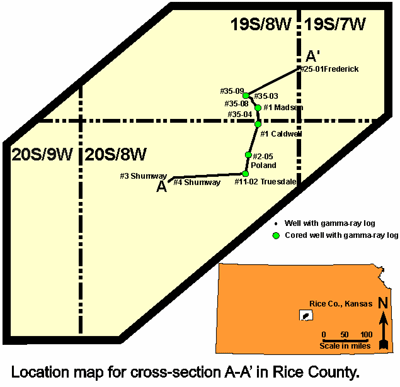
Integrating Plug to Well-Scale Petrophysics with Detailed Sedimentology to Quantify Fracture, Vug, and Matrix Properties in Carbonate Reservoirs
Kansas Geological Survey
Open-file Report 99-47
 |
Integrating Plug to Well-Scale Petrophysics with Detailed Sedimentology to Quantify Fracture, Vug, and Matrix Properties in Carbonate Reservoirs |
Kansas Geological Survey Open-file Report 99-47 |
Arbuckle Cyclicity
Arbuckle strata in Kansas are interpreted to have been deposited on a broad shallow shelf in shallow subtidal to peritidal environments, similar to what is recognized in Arbuckle-equivalent strata elsewhere in the Midcontinent. The stratigraphic section consists of hundreds of feet of largely dolomitized subtidal to peritidal cyclic carbonates with karst overprinting in the upper portion as a result of prolonged exposure related to the overlying post-Arbuckle Sauk-Tippecanoe unconformity.
|
 |
Lateral Extent of StrataAnalysis of wire-line logs (shown above) suggests that key marker beds, including thin shale beds (1 to 5 feet thick), can be correlated over distances of more than ten miles. Cross-section A-A' (Figure 7) shows correlation of marker beds in central Rice County. In this region 13 units are identifiable on logs comprising 39 shoaling upward cycles. Regionally, 16 units are defined, of which the uppermost five units are interpreted to be partially or completely truncated by the post-Arbuckle unconformity at many locations across Rice County on the Central Kansas Uplift. Over interwell distances, continuity of lithofacies is evident indicating petrophysical properties of lithofacies are also laterally extensive. |

|
|
e-mail : webadmin@kgs.ku.edu
Last updated November 2002
http://www.kgs.ku.edu/PRS/Poster/1999/99-47/P1-05.html